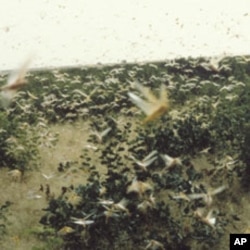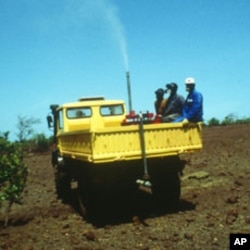Madagascar is facing a potential locust plague. The U.N. Food and Agriculture Organization says urgent action is needed before mid-October to prevent widespread crop destruction.
The FAO says the Malagasy Migratory Locusts are usually contained in the southwest corner of the country. However, the last rainy season created ideal breeding conditions, and the locusts are now spreading to the north and east. The government estimates about 460,000 rural families may be at risk.
FAO locust officer Annie Monard says, “The fact that in the traditional outbreak area of migratory Malagasy locusts in Madagascar… there were already swarms produced at the end of the previous rainy season --and due to the fact that a number of them escaped this area - it’s for us a good indication that locusts are becoming a very dangerous pest.”
Eat everything
There are many different kinds of locusts, but Monard says the Malagasy Migratory Locusts can be particularly hungry and destructive.
“It’s a subspecies of [the] migratory locust, which is very well known,” she says, “in Europe, in Africa and in Asia….which is well known as a most dangerous crop pest in Madagascar.”
She says as soon as the locusts form hopper (young, wingless locusts) bands and then swarms, “they are able to eat everything. And of course in particular rice crops and all kinds of cereals.”
Preventing a plague
The FAO says a control campaign must be started before the mid-October rainy season to prevent them from “reaching plague proportions.”
Monard says, “They should be controlled as soon as possible. I mean as soon as first groups are observed. It should be necessary to treat them with pesticide that we have now in hand. There’s a wide range of pesticide less harmful for the environment than they were in the past.”
Madagascar is considered to be in an emergency situation and at least 500,000 hectares will have to be treated. Most of the pesticide, she says, would be sprayed by air.
The FAO locust expert says there are different levels of locust infestation, ranging from little activity to country-wide invasion.
“This outbreak can progressively become an upsurge…. And if, more or less, all Madagascar would be infested we will speak of a plague. It’s an ultimate level of infestation of locusts,” says Monard.
In southwestern Madagascar, the locusts often do not swarm, but simply live their lives as individuals.
However, the FAO says when locust populations rise dramatically they reach a “tipping point.” When that happens, the locusts’ body chemistry actually changes and “undergoes behavioral, ecological and physiological transformation.”
At that point, the FAO says they begin to concentrate and act as “synchronized groups” of hopper bands. It says they then move “en masse to find new sources of food capable of supporting their numbers and suitable for breeding.”
The pests can fly up to 100 kilometers a day.








